4 - The Roman Colony
Room

 |
|
 |
|
21 |
Giallo Antico Corniches from Bulla Regia |
|
22 |
Simitthus in the Roman Province |
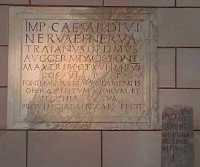 |
23 |
Simitthus and Roman Roads
Dedication inscription of Traian´s "new" bridge crossing the river
Bagrada at Simitthus, the second Roman bridge. (The first one was
built perhaps already under Emperor Tiberius, being destroyed down to its
foundation by floods or earthquakes.)
This inscription dates the new bridge into the Emperor's 16th tribunicial
power ( Dec. 111 to Dec. 112 C.E.). He is already acclaimed
"optimus Augustus" (by the African military?) although the Senate only
awarded him this title as late as 2nd half of August. 114 C.E.
The completely new bridge (a fundamentis) was the work of "his
soldiers" (militumsuorum) and at his own expense (pecuniasua).
The 'Area' page shows a view of the bridge's ruins. |
 |
24 |
Economy of Simitthus
The marble quarries were property of the Emperors, but the wealth of the
citizens in Coloni Iulia Augusta Numidica Simitthus (CIANS) as throughout
the African urban sphere depended on agriculture. African barley and wheat
was vital for the masses of the city of Rome. Chimtou boasts one
of the two water driven turbine flour mills of Roman Africa hitherto known.
(Motor pump and water-driven scale model in Room 4 by G.and J.Röder).
Next to it a Roman hour-glass mill which has also been reset to function
for the museum visitor.
|
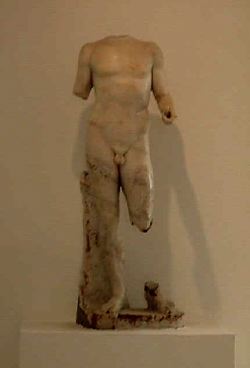 |
25 |
Athlete Boy (Dresden type)
There are more than a dozen copies in the galleries of Ancient Art throughout
the world of this fourth cent. BCE statue of an athlete boy. It originated
in the studio of Athenian scultpor Polycletes in the 4th
century B.C.E. The Chimtou copy is the only one known to have a preserved
arm. Judging from its pose it once held a (copper?) strigilis, a crescent-
shaped scratching instrument to clean the body from oily dust when one
sorted from the gymnasium. In the right hand, consequently, he must have
had his globular gymnastic oil bottle. The subject, known as the Dresden
type, is a Roman time copy of Aegaean insular marble and might have served
as image of a youthful god in the 2nd and 3rd cent.C.E. |
|
26 |
Bacchus Mosaic |
|
27 |
View of Simitthus. A view of 3rd century C.E.Simitthus, painted by
J.-C-Golvin. |
|
28 |
Door of a Countryside Sanctuary |
|
29 |
Alexander Severus as Hercules |
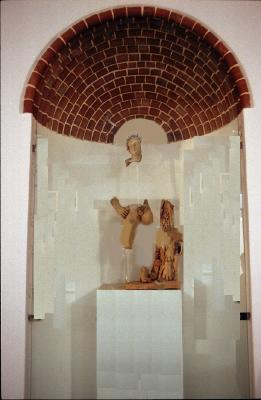 |
|
a)
An emperor (Commodus? Alexander Severus?) as the God Hercules.
A bit over 90 cms, half life-size, must have measured the terra cotta-group of an
emperor with sword and lionęs skin,accompanied by the Cerynitian hinde, found in his
excavations by Friedrich Rakob. In the museum it was set into a small apse, vaulted
by a tube vault (see drawing) by architect S.Storz as an experimental part of his
research on this ancient building technique. He found the earliest example of such
vaulting in Africa in the central prison hall of the quarry slave labor camp at Simitthus
(3rd quarter of 2nd cent.AD), before it became so typical for 3rd to 5th cent.AD North Africa
in the vaults of the carcer in the slave labor camp of the Simitthus marble quarries.
He is of the opinion that this technique was originally applied in vaulting pottery kilns.
He kindly provided the following comment:
|
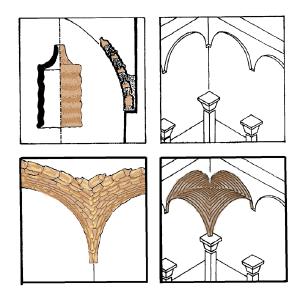 |
|
b)
The earliest known example of a vault using terra cotta tubes was found at Morgantina
in Sicily in a round room (laconicum) of a small bath building from the end of 3rd or
beginning of 2nd cent.B.C. The first Roman construction tubes come perhaps from a house
of 1st.cent.AD in Pompeii, but the evidence of their vaulting function is still in doubt.
In the 2nd.cent. AD the use of tubes for vaults became an established building technique.
Soon spreading from Roman Africa as a center towards the West it is even exported throughout
much of the western Roman Empire such as to Italy, Late Roman Spain, France, England,
Hungary, Croatia, with some examples even in Palestine and Syria. The Roman non-military
province of Africa Proconsularis persists as the focus while in England and Syria their
rare appearance is linked to military constructions. Thus, the Late Roman army may perhaps
be responsible for its exportation to the armed periphery. Tube vaulting originally was
introduced into the Roman architecture to serve as mouldings for vaulting in opus
caementitium at a period facing an increasing lack of wood.
Soon Roman architects found out that tube vaulting allowed to devel new forms of rich
composite vaulting by domes which escaped archaeologists and architectural students
until this recent research.
|


  
|
30 |
Regional Roman Sculpture
Regional sculpture of Africa Proconsularis with its Berber, Punic-Hellenistic
and Roman influence. It has not yet been studied in detail as in
other Roman provinces. A half life-size regional representation of
a god, holding a bird in his left and an iron trident in his right (not
attached)was found a mile from the Roman Colonia Iulia Augusta
Numidica Simitthensium towards the neighbouring colony of Thuburnica.
A rotund of indigenous stelae from a regional countryside sanctuary
to commemorate pilgrimages with sacrifices of rams and perhaps acts of
gratitude for healings. |
|
31 |
The Sacred Hill of Chimtou |
|
32 |
Graves of Roman Chimtou |
|
33 |
Benefactors of Roman Chimtou |
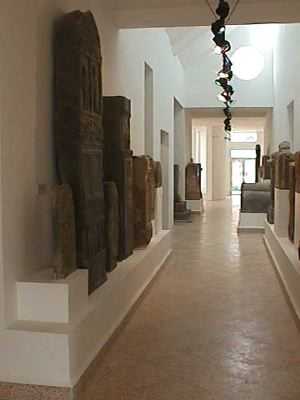 |
34 |
Roman Funeral Monuments
Numerous gravestones of 1st to 4th cent.C.E., most of them with revealing
inscriptions, tell us about the Roman population of the Simitthus area. |